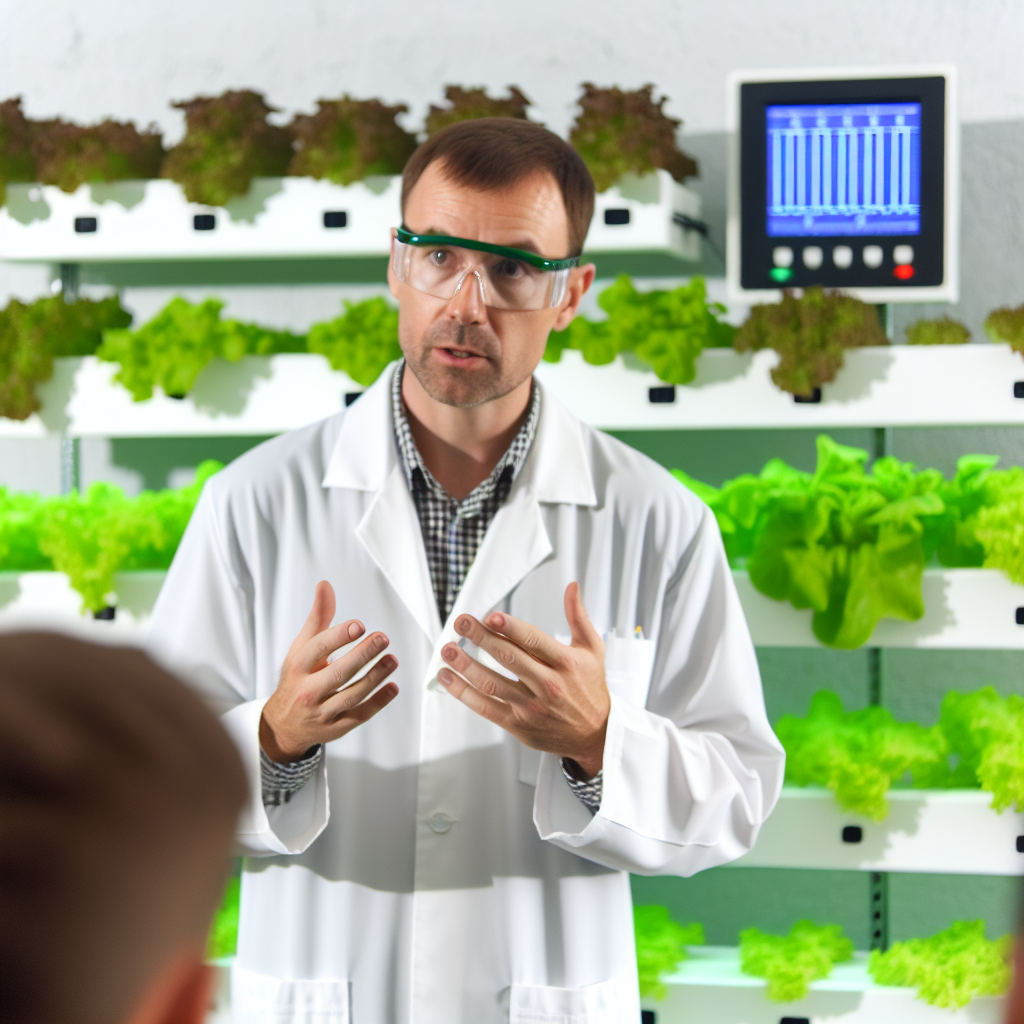Introduction to Hydroponics
Hydroponics is a method of growing plants without soil.
Instead, it uses nutrient-rich water to nourish plant roots.
This innovative approach allows for precise control over plant growth.
As a result, it often leads to faster growth rates and higher yields.
In addition, hydroponics can reduce the need for pesticides and herbicides.
Overall, this technique reflects an efficient, sustainable way of farming.
Benefits of Hydroponic Systems
Hydroponics offers several advantages over traditional soil farming.
First, it makes efficient use of space.
Growers can produce more food in smaller areas.
This method also conserves water compared to conventional agriculture.
Furthermore, hydroponics allows for year-round crop production.
Types of Hydroponic Systems
There are various hydroponic systems available, each with unique features.
Nutrient Film Technique (NFT) continuously circulates a nutrient solution.
Deep Water Culture (DWC) suspends plant roots in nutrient solution.
Wicking systems use capillary action to draw nutrients to the plants.
Transform Your Agribusiness
Unlock your farm's potential with expert advice tailored to your needs. Get actionable steps that drive real results.
Get Startedebb and Flow systems periodically flood the growing area with nutrients.
Lastly, aeroponics mist roots with a nutrient solution, providing high oxygen levels.
Key Components of Hydroponic Systems
Successful hydroponics relies on several critical components.
A nutrient solution provides essential minerals and nutrients.
Growing mediums support the plants while retaining moisture.
Common mediums include rock wool, clay pellets, and coconut coir.
Additionally, lighting is crucial for indoor hydroponics.
Growers often use LED or fluorescent lights to ensure proper growth.
Challenges of Hydroponics
Despite its advantages, hydroponics presents unique challenges.
System failures can quickly lead to plant loss.
Moreover, careful monitoring is required to prevent nutrient imbalance.
Hydroponic setups can also involve higher initial costs.
Nevertheless, many growers find these challenges manageable and rewarding.
Historical Development of Hydroponic Systems
Early Innovations in Hydroponics
The history of hydroponics dates back to ancient civilizations.
The Hanging Gardens of Babylon likely used a form of hydroponic system.
In the 17th century, researchers began experimenting with growing plants without soil.
Notably, the botanist Francis Bacon conducted early studies on plant nutrition.
Modern Advances and Research
The 1930s marked a significant advancement in hydroponic technology.
Researchers at the University of California, Berkeley, pioneered modern hydroponic systems.
They developed nutrient solutions that revolutionized plant growth methods.
In the 1960s, Dr. Alan Cooper published influential research on hydroponics.
Commercial Adoption and Expansion
During the 1980s, hydroponics gained popularity among commercial growers.
Commercial greenhouses began implementing hydroponic systems for efficiency.
Moreover, advancements in technology facilitated better control of growing conditions.
Showcase Your Farming Business
Publish your professional farming services profile on our blog for a one-time fee of $200 and reach a dedicated audience of farmers and agribusiness owners.
Publish Your ProfileThis trend led to increased yields and reduced resource usage.
Recent Trends and Innovations
Today, hydroponics continues to evolve with innovative technologies.
Aeroponics, a technique where roots are misted with nutrients, gains traction.
Furthermore, vertical farming integrates hydroponics for urban agriculture.
These systems enhance space utilization and facilitate local food production.
Global Impact of Hydroponics
Hydroponics plays a crucial role in addressing food security issues.
It allows cultivation in areas with poor soil quality or limited arable land.
Additionally, hydroponics significantly reduces water consumption compared to traditional farming.
Hence, it becomes essential for sustainable agricultural development worldwide.
Types of Hydroponic Systems: An Overview
Deep Water Culture
Deep water culture is one of the simplest hydroponic systems.
In this system, plants float on a nutrient-rich solution.
The roots grow directly into the water, absorbing nutrients efficiently.
Additionally, air pumps supply oxygen to the plant roots.
Nutrient Film Technique
The nutrient film technique uses a thin film of nutrient solution.
This film continuously flows over the plant roots.
Consequently, plants receive essential nutrients while preventing waterlogging.
This system is particularly effective for leafy greens.
Ebb and Flow System
The ebb and flow system is versatile and widely used.
It periodically floods the plant roots with nutrient solution.
Then, it drains back into a reservoir for reuse.
This cycle allows the roots to access oxygen and nutrients effectively.
Drip Systems
Drip systems work by delivering nutrient solution directly to plant roots.
They use a network of tubes and emitters for precision watering.
This method conserves water and reduces waste significantly.
Moreover, it is suitable for various plant types, including fruits and vegetables.
Aeroponics
Aeroponics offers a cutting-edge method for growing plants.
It suspends plants in the air while misting their roots with nutrients.
This technique maximizes oxygen exposure, promoting rapid growth.
Additionally, it reduces water usage compared to traditional methods.
Vertical Farming Units
Vertical farming units utilize vertical space for crop production.
These systems can incorporate various hydroponic techniques.
As a result, they enhance space efficiency in urban settings.
This method supports year-round production in controlled environments.
Choosing the Right Hydroponic System
Selecting the right hydroponic system depends on several factors.
Consider available space, types of plants, and resource access.
Additionally, evaluate your experience level with hydroponics.
Ultimately, the best system aligns with your growing goals and conditions.
Explore Further: Precision Agriculture Techniques For Disease Forecasting
Components of a Hydroponic System
Essential Parts Explained
A hydroponic system relies on various essential components.
Each part plays a crucial role in enabling plant growth without soil.
Showcase Your Farming Business
Publish your professional farming services profile on our blog for a one-time fee of $200 and reach a dedicated audience of farmers and agribusiness owners.
Publish Your ProfileGrowing Medium
The growing medium supports the plant roots and retains moisture.
Common options include rock wool, clay pellets, and coconut coir.
These mediums provide stability while allowing nutrient absorption.
Nutrient Solution
The nutrient solution delivers essential minerals to the plants.
It contains water mixed with fertilizers tailored for hydroponics.
This solution circulates through the system to nourish the plants.
Water Pump
A reliable water pump circulates the nutrient solution.
It moves the solution from the reservoir to the plants efficiently.
Investing in a quality pump is vital for system performance.
Reservoir
The reservoir holds the nutrient solution before it reaches the plants.
Its size depends on the scale of the hydroponic system.
A well-maintained reservoir ensures a consistent supply of nutrients.
Lighting System
Good lighting is crucial for plant photosynthesis.
Many hydroponic setups use LED or fluorescent grow lights.
These lights mimic sunlight, promoting healthy plant growth indoors.
Growing Container
Growing containers hold the plants in place during their growth cycle.
They come in various shapes and sizes, depending on the system.
Containers can be net pots, trays, or other suitable options.
Air Pump and Oxygenation
An air pump introduces oxygen into the nutrient solution.
This process enhances root health and promotes nutrient uptake.
Oxygenation is essential for maintaining vigorous plant growth.
pH and EC Meters
Monitoring tools like pH and EC meters are vital for success.
These meters help growers maintain optimal nutrient levels.
Regular testing ensures plants receive the right balance of nutrients.
Support Structures
Support structures provide stability for tall or vining plants.
They can include trellises, stakes, or even netting.
These structures help prevent plants from falling over during growth.
Learn More: Mulching Techniques to Boost Crop Productivity
Advantages of Hydroponics
Benefits Over Traditional Farming
Hydroponics offers numerous benefits compared to traditional farming methods.
Firstly, it utilizes significantly less water.
This efficiency stems from a closed-loop system.
In this system, water recycles, reducing waste.
Secondly, hydroponics allows for year-round crop production.
This consistency enhances food availability at all times.
Moreover, it minimizes the impact of weather conditions.
Consequently, growers can predict yields more accurately.
Hydroponic systems also optimize space usage.
Plants grow closer together, increasing yield per square foot.
This compact arrangement is perfect for urban settings.
Additionally, hydroponics reduces the need for pesticides.
Showcase Your Farming Business
Publish your professional farming services profile on our blog for a one-time fee of $200 and reach a dedicated audience of farmers and agribusiness owners.
Publish Your ProfileThis approach promotes healthier and chemical-free produce.
Furthermore, it allows for the growth of a wide variety of plants.
Growers can cultivate anything from lettuce to herbs and tomatoes.
As a result, crops can be tailored to market demands.
Overall, hydroponics integrates technology and agriculture efficiently.
This integration fosters innovation in food production.
Environmental Benefits
Hydroponics greatly minimizes land use.
By growing more food in smaller areas, it protects natural habitats.
Additionally, fewer resources are necessary for crop management.
This contributes to sustainable agricultural practices.
As a bonus, the control over nutrient delivery leads to faster growth rates.
Thus, crops can reach maturity in a fraction of the time.
Economic Advantages
The economic benefits of hydroponics are substantial.
Initial setup costs may be higher, but long-term savings are significant.
Lower water and pesticide costs contribute to profitability.
Moreover, farmers can produce high-value crops.
These crops can yield more revenue than traditional crops.
In essence, hydroponics supports a more sustainable farming business model.
Learn More: Training Farmers on Effective Post-Harvest Techniques

Challenges and Limitations of Hydroponics
Initial Setup Costs
The cost of establishing a hydroponics system can be high.
Start-up expenses include equipment, nutrient solutions, and growing mediums.
Additionally, quality systems often require professional installation.
This can deter some potential growers from starting their hydroponic journey.
Technical Knowledge and Skills
Hydroponics demands a higher level of technical knowledge.
Understanding nutrient balance and system management is crucial.
New growers may struggle to grasp these concepts initially.
Continuous learning is necessary for successful operation.
Resource Intensive
Hydroponics often uses more water than traditional farming methods.
This process requires careful monitoring to prevent waste.
Moreover, electrical systems can fail, causing significant losses.
Maintenance and repair are ongoing commitments for growers.
Pest and Disease Management
Even in controlled environments, pests can be a challenge.
Preventive measures must be taken to protect crops.
Diseases can spread rapidly in closed systems.
Growers need to stay vigilant to manage these risks.
Market Limitations
Hydroponically grown produce may face market acceptance issues.
Some consumers prefer conventionally grown products.
Marketing strategies must highlight the benefits of hydroponics.
Establishing a brand can take time and effort.
Environmental Considerations
Hydroponics systems can impact the environment negatively.
Showcase Your Farming Business
Publish your professional farming services profile on our blog for a one-time fee of $200 and reach a dedicated audience of farmers and agribusiness owners.
Publish Your ProfileImproper disposal of nutrient solutions may contaminate local waterways.
Electricity use can exacerbate carbon footprints.
Responsible practices are essential to mitigate these effects.
Explore Further: IoT Sensors Transforming Crop Analytics Today
Nutrient Solutions in Hydroponics: Composition and Importance
Understanding Nutrient Solutions
Nutrient solutions deliver essential nutrients to plants in hydroponic systems.
These solutions provide a balanced mixture of micronutrients and macronutrients.
Both types of nutrients are necessary for healthy plant growth.
Macronutrients include nitrogen, phosphorus, potassium, calcium, magnesium, and sulfur.
Micronutrients, on the other hand, consist of iron, manganese, zinc, copper, molybdenum, and boron.
Components of Nutrient Solutions
The composition of nutrient solutions varies based on plant requirements.
Water acts as the primary solvent for these solutions.
Additionally, it facilitates nutrient absorption by the plants.
Many hydroponic growers use commercially available nutrient formulations.
Some prefer to mix their own solutions to tailor specific needs.
Importance of Balanced Nutrition
Balanced nutrient solutions enhance plant growth and yield.
Plants require different nutrient concentrations at various growth stages.
For example, during the vegetative stage, nitrogen levels should be higher.
In the flowering stage, phosphorus and potassium become more critical.
Regular monitoring of these levels ensures optimal plant health.
Common Nutrient Solution Formulations
- General-purpose formulations are suitable for most plants.
- Specialized mixes cater to particular crops, such as tomatoes or lettuce.
- Organic nutrient solutions use natural ingredients to nourish plants.
- Mineral-based solutions provide essential nutrients in inorganic forms.
Challenges in Nutrient Management
Over-fertilization can lead to nutrient toxicity in plants.
Conversely, under-fertilization may result in deficiencies.
Regular testing of nutrient solutions helps prevent these issues.
Using pH and EC meters can provide insight into nutrient balance.
Adjusting nutrient concentrations is crucial for successful hydroponics.
Future Trends in Hydroponics: Innovations and Sustainability
Emerging Technologies
Innovative technologies are revolutionizing hydroponics systems.
For instance, automation is enhancing efficiency in nutrient delivery.
Additionally, sensors monitor plant health and environmental conditions.
Robotics streamline planting, harvesting, and maintenance processes.
Vertical Farming
Vertical farming presents a space-efficient solution for urban areas.
This method maximizes crop yield per square foot of land.
It also reduces transportation costs, benefiting local food systems.
Moreover, vertical farms often use renewable energy sources.
Sustainability Practices
Sustainability remains a key focus in hydroponic innovation.
Closed-loop systems conserve water and minimize waste effectively.
Using renewable energy sources enhances overall sustainability.
Moreover, integrating aquaponics adds another layer of efficiency.
Consumer Trends
Consumers are increasingly demanding locally sourced produce.
This trend drives the growth of urban hydroponic farms.
Health-conscious individuals prefer pesticide-free crops.
Consequently, hydroponics aligns perfectly with these consumer preferences.
Showcase Your Farming Business
Publish your professional farming services profile on our blog for a one-time fee of $200 and reach a dedicated audience of farmers and agribusiness owners.
Publish Your ProfileCollaborations and Research
Partnerships between universities and industry leaders fuel innovations.
Research focuses on improving crop varieties suited for hydroponics.
Moreover, sharing knowledge fosters advancements in sustainable practices.
Ultimately, collaboration enhances the entire hydroponics ecosystem.
Additional Resources
Hydroponics: current trends in sustainable crop production – PMC




